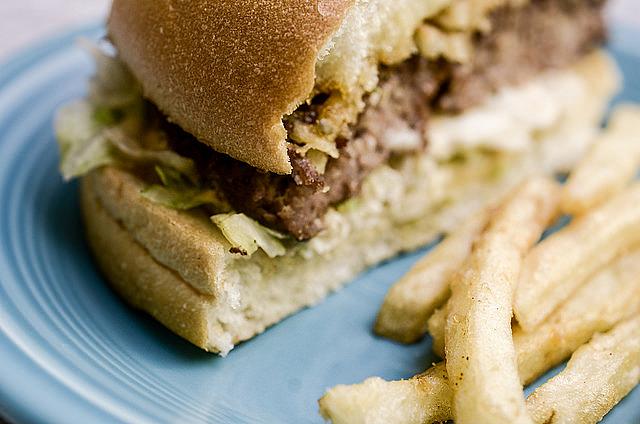Low-income Maine children more likely to be obese
Patty Wight reported this story with the support of the Dennis A. Hunt Fund for Health Journalism and the National Health Journalism Fellowship, programs of USC Annenberg’s Center for Health Journalism.
Other stories in the series include:
For Maine families depending on SNAP for groceries, every penny counts

LEWISTON, Maine — More than a third of children and adolescents in the U.S are overweight or obese, according to the U.S. Centers for Disease Control. That’s twice as many overweight children than there were 30 years ago, and four times the number of overweight adolescents.
Kids with extra weight are at a higher risk for chronic health conditions, such as heart disease and diabetes, and for mental health issues as well. And children from low-income families are especially vulnerable.
This report kicks off a series on the link between childhood poverty and obesity with the story of a low-income Maine family struggling to serve healthy food on a limited budget.
It’s nearing dinner time at Miriam Fuentes’ house in Lewiston. When her 13-year-old granddaughter Evalisa Hernandez wanders into the kitchen, she’s thrilled to see breaded cube steak sizzling in a frying pan.
“Ooh — you’re frying them? I’ll eat it!” Hernandez says.
Fuentes, who takes care of her granddaughter, is on disability for multiple health issues. She gets about $200 a month in assistance to buy food.
“It’s not enough, with the way food prices are, to buy everything I need,” she says.
Fuentes says her choices are limited by her budget, and by a lack of reliable transportation. She counts on friends to give her rides to the grocery store, and she also depends on a weekly trip to a food pantry.
Meals like spaghetti with butter or cheese, she says, make a frequent appearance on her granddaughter’s plate.
“It’s cheap, and it’s there,” Fuentes says. “But it’s not healthy. It makes you feel guilty. That you’re harming your grandkids, not helping them.”
And Hernandez admits that even at the age of 13, she worries about her weight.
“I’ve gained weight and I don’t really like it because when I was younger I used to not be so heavy, so it’s kind of hard,” she says.
According to the Maine Children’s Alliance, 30 percent of Maine kids ages 10-17 are overweight. That’s more than 36,000 kids, and nearly half of those are considered obese, defined as a body mass index at or above the 95th percentile for their age and gender.
“There’s an epidemic of childhood and adult obesity,” says Dr. Mike Dedekian, a pediatric endocrinologist at Barbara Bush Children’s Hospital in Portland.
Dedekian says obesity has created alarming changes in childhood health. Type 2 diabetes, for example, used to be called adult-onset diabetes, but that name has been scrapped, as the disease is now seen in children as young as 8 and 9 years old.
“These diseases we didn’t traditionally think of as pediatric diseases are the bread and butter that we see every day,” he says.
What the health care community also sees is a connection between weight issues and income. That connection varies by ethnicity and gender. But the 2012 National Survey of Children’s Health found that in general, the lower the household income, the higher the rate of children who are overweight or obese.
It may seem counterintuitive that those who struggle to put food on the table can also struggle with their weight. Jim Weill of the Food Research and Action Center says low-income families face unique challenges in accessing healthy food. A lack of reliable transportation plays a role. And, says Weill, those with low incomes may tend to choose the cheapest food that offers the most calories — think a bag of chips versus a bag of carrots.
“The other thing that gets into it is when people don’t have enough resources for food, they get into more frequent cycles of food deprivation and overeating,” he says.
That “feast or famine” pattern, along with added stress and anxiety, can creates hormonal changes that contribute to weight gain. As do foods high in refined carbohydrates, such soda, chips and sugary snacks, Dedekian says.
“They trigger hormones in the body that tell you to eat more, and the more extra weight you have, the more the hormone system breaks down that are supposed to tell us we’re full,” he says.
Dedekian says these biological and environmental forces are difficult to overcome with willpower alone.
“I’m not absolving people from all personal responsibility, but there are hormone mechanisms at play once you start to gain extra weight that make it harder and harder and harder to lose weight and get back to a normal weight,” he says.
But there are programs aimed at helping low-income Mainers develop healthy eating habits.
Ruth Cyr, an educator with the University of Maine Cooperative Extension’s Eat Well Program, makes home visits to teach parents how to cook nutritious meals on a budget. On this day, she has come to encourage Fuentes to shift from spaghetti and meat-and-potato meals to soups and stir fries, so she can stretch the meat and pack in more vegetables.
“Stick to the nonstarchy vegetables if you can — your broccoli, your carrots, your spinach, your cauliflower, things like that,” Cyr says.
These nonstarchy vegetables are important for Fuentes because she’s diabetic, and her granddaughter is also at risk. Hernandez says she’s trying to be more mindful of what she eats.
“I don’t like looking like this,” she says. “I want to be not so overweight and stuff. I want to be able to do sports and be athletic and all that.”
[This story was originally published by MPBN News.]
Photo via Flickr

